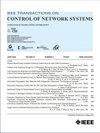On the Constrained CAV Platoon Control Problem
IF 4
3区 计算机科学
Q2 AUTOMATION & CONTROL SYSTEMS
引用次数: 0
Abstract
The main objective of the connected and automated vehicle (CAV) platoon control problem is to regulate CAVs' position while ensuring stability and accounting for vehicle dynamics. Although this problem has been studied in the literature, existing research has some limitations. This article presents two new theoretical results that address these limitations: the synthesis of unrealistic high-gain control parameters due to the lack of a systematic way to incorporate the lower and upper bounds on the control parameters, and the performance sensitivity to the communication delay due to inaccurate Taylor series approximation. To be more precise, taking advantage of the well-known Padé approximation, this article proposes a constrained CAV platoon controller synthesis that systematically incorporates the lower and upper bounds on the control parameters, and significantly improves the performance sensitivity to the communication delay. The effectiveness of the presented results is verified through conducting extensive numerical simulations. The proposed controller effectively attenuates the约束CAV排控问题研究
网联自动驾驶汽车(CAV)队列控制问题的主要目标是在保证车辆稳定性和考虑车辆动力学的情况下调节CAV的位置。虽然已有文献对这一问题进行了研究,但现有的研究存在一定的局限性。本文提出了两个新的理论结果来解决这些限制:由于缺乏系统的方法来结合控制参数的下界和上界而合成不切实际的高增益控制参数,以及由于不准确的泰勒级数近似而导致的对通信延迟的性能敏感性。更精确地说,本文利用著名的pad近似,提出了一种约束CAV排控制器综合,系统地结合了控制参数的下界和上界,显著提高了性能对通信延迟的灵敏度。通过大量的数值模拟,验证了所得结果的有效性。所提出的控制器有效地衰减了走走停停的扰动——在整个混合队列(由自动驾驶汽车和人类驾驶的车辆组成)中,一个单一的减速周期随后是加速放大。现代交通系统将从拟议的自动驾驶汽车控制中受益,因为它可以有效地衰减干扰,因为它可能会减少碰撞。
本文章由计算机程序翻译,如有差异,请以英文原文为准。
求助全文
约1分钟内获得全文
求助全文
来源期刊

IEEE Transactions on Control of Network Systems
Mathematics-Control and Optimization
CiteScore
7.80
自引率
7.10%
发文量
169
期刊介绍:
The IEEE Transactions on Control of Network Systems is committed to the timely publication of high-impact papers at the intersection of control systems and network science. In particular, the journal addresses research on the analysis, design and implementation of networked control systems, as well as control over networks. Relevant work includes the full spectrum from basic research on control systems to the design of engineering solutions for automatic control of, and over, networks. The topics covered by this journal include: Coordinated control and estimation over networks, Control and computation over sensor networks, Control under communication constraints, Control and performance analysis issues that arise in the dynamics of networks used in application areas such as communications, computers, transportation, manufacturing, Web ranking and aggregation, social networks, biology, power systems, economics, Synchronization of activities across a controlled network, Stability analysis of controlled networks, Analysis of networks as hybrid dynamical systems.
 求助内容:
求助内容: 应助结果提醒方式:
应助结果提醒方式:


